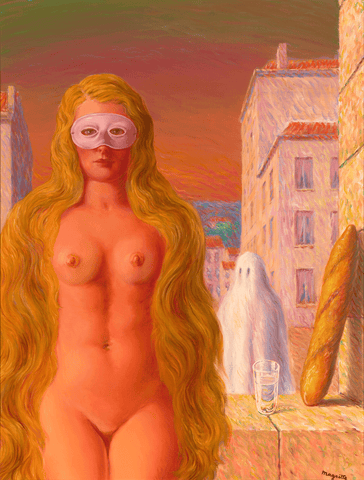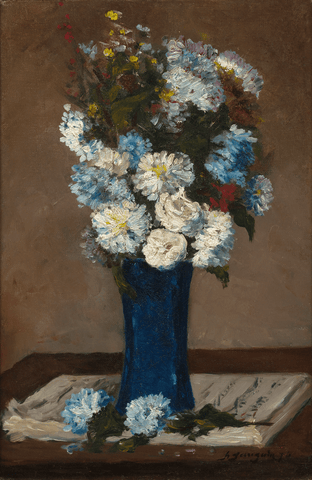As the grandson of Impressionist painter Camille Pissarro, Hugues Claude Pisarro carries out his family tradition with the utmost beauty and detail. With vibrant hues and textured brushstrokes, Hugues Claude Pissarro, also known professionally as H. Claude Pissarro or Isaac Pomie, has produced an incredible body of work in his lifetime. Pissarro utilizes a profusion of color and painterly pastel strokes to create visually intoxicating work that typifies nature in its truest form. Throughout his oeuvre, Pissaro uses beautiful pastels that exemplify the intimate and expressive potential of the medium.
 Dimanche au champ de course by H. Claude Pissarro. M.S. Rau.
Dimanche au champ de course by H. Claude Pissarro. M.S. Rau.
Early Life
Born in 1935 in Neuilly-sur-Seine, H. Claude Pissarro was named after his godfather, Claude Monet. Paul Émile, H. Claude’s father, was one of five sons to the great Camille Pissarro and was taught by his father in an informal art school within the home. Keeping the family tradition alive, H. Claude was also taught to paint by his father. He exhibited talent at an early age and his predecessors were eager to observe the artwork he produced.
Because of his father’s deep art world connections, H. Claude was enveloped in an artistic environment from an early age. He exhibited his first work at the young age of fourteen and subsequently studied in Paris at prestigious establishments such as
École Normale Supérieure, a distinguished French art school committed to achievement and distinction to which only the academic elite have access. He also studied art restoration at Musée du Louvre under creative artist, Henri Linard.
 La Marne, Quai de La Gourdine. M.S. Rau.
La Marne, Quai de La Gourdine. M.S. Rau.
Gourdine, a man luxuriates in the afternoon sun as he sits beside his boat on the banks of the Marne river in this picturesque vista of the French countryside. Hugues Claude Pissarro renders his idyllic scene in exquisite detail, utilizing a plethora of painterly brushstrokes to create the windswept tall grasses, verdant trees and reflective blue water.
A Wide Breadth of Styles
Although the Pissarro family legacy mainly consists of Impressionism and Post-Impressionism, of which H. Claude excels in, he painted in a wider breadth of styles including abstract, minimalist, and conceptual work. In fact, at the age of 24, he was commissioned by the White House to paint a portrait of 34th U.S. President, Dwight Eisenhower. Due to his early and collaborative exposure to the art world, H. Claude’s work evolved throughout his career as he touched on these differing styles.
H. Claude’s exposure to wide-ranging influences within the Post-Impressionist movement resulted in his experimentation in a variety of art media. Not only is he a painter of landscapes and portraits, but he has also explored engraving
, lithography, and publishing.
His elite educational background inevitably led him to become a professor of art whilst carrying out his own art practice, and in 1963, he accepted an invitation to teach in Monaco. He is known to share his technique of applying paint straight from the tube directly onto the canvas with great speed, resulting in a beautifully rich texture. Throughout his teaching career, he remained a prolific artist and exhibited several times in Paris and London.
A lush landscape rife with flowering blooms, sparkling blue water and flourishing trees fills Les Nénuphars. The artist renders leafy plants and delicate snap dragons in the foreground, with a Bougainvillea-strewn trellis in the distance on the other side of a reflective pond. A white dress-clad woman stands in the dappled sunshine beneath the trellis, taking in the splendor of the garden setting. This beautiful pastel celebrates both the vitality and tranquility of nature.
 Les Nénuphars by H. Claude Pissarro. M.S. Rau.
Les Nénuphars by H. Claude Pissarro. M.S. Rau.
Later Career and Legacy
After experimenting with many different styles and mediums, H. Claude always returns to his signature Post-Impressionistic style. However, the artist’s work continues to reflect his passion for producing both his classic Post-Impressionistic pieces along with different styles.
A collaborative artist like his father, he worked within a movement deemed, “Support-Surface,” an elucidated painting fad during the 1970s defined by attaching artistic significance to all aspects of the painter’s life, down to the blank canvas and tools. This spurred an artist colony in an old manor house outside of Paris, in which he and his peers experimented and soul searched. During this time it is said that H. Claude produced abstract works alongside his colleagues during the day, but could not escape his traditional roots and carried out his Post-Impressionistic work by night. During this period he began to sign and sell his traditional work by the assumed name Isaac Pomie.
La Grand’Route à Golfe-Juan by H. Claude Pissarro. M.S. Rau.
The seaside town of Golfe-Juan in the south of France has served as visual inspiration for artists from Paul Signac to Claude Monet. Post-Impressionist H. Claude Pissarro’s rendition, La Grand’Route à Golfe-Juan, takes a differing perspective from his artistic predecessors, focusing on the busy life onshore in the small town center, rather than the Mediterranean seascape. Using his distinctive effusive brushwork, H. Claude Pissarro’s colorful palette and skillful application of paint breathe a lifelike vibrancy into this bustling city scene.
Although the artist has lived in Ireland with his family for many years, his subjects and legacy famously draw from Parisian city life or the French countryside. His use of pastels for these scenes set him apart from many artists of his day, perhaps because of the labor-intensive nature of the medium. His aim is to capture a romantic past, with most of his subjects in 19th-century dress walking among horse and buggies. H. Claude’s work is still being collected with the utmost desire and, in his 86th year, he continues to paint with a passion.

















